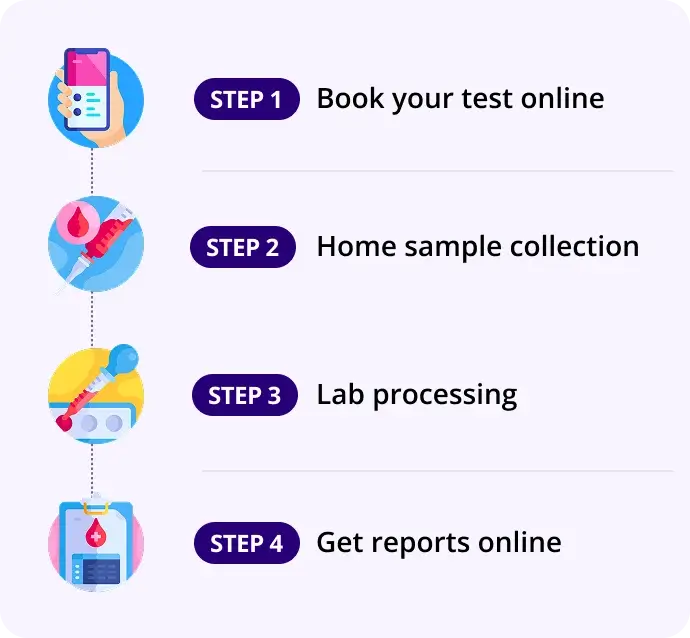Herpes Simplex Virus I (HSV) - IgM
Unit Test
Report in 24Hrs
At Home
No Fasting Required
Details
Detects IgM antibodies specific to: HSV-1: Commonly causes oral herpes (cold sores)
₹249₹385
35% OFF
HSV-1 IgM Test Information Guide
- Herpes Simplex Virus I (HSV)-IgM
- Why is it done?
- Detects IgM antibodies produced during primary or acute HSV-1 infection
- Identifies newly acquired HSV-1 infection to differentiate from recurrent infections
- Diagnoses acute herpes simplex keratitis, gingivostomatitis, or encephalitis
- Confirms HSV-1 as causative agent in patients with acute clinical symptoms
- Performed during early phase of infection when IgM antibodies are present (typically within first 2 weeks)
- Assists in epidemiological tracking and outbreak investigations
- Normal Range
- Normal Result: Negative or <1.10 Index Value (varies by laboratory)
- Positive Result: ≥1.10 Index Value or positive antibody titer (indicates recent or primary infection)
- Units of Measurement: Index Value (S/CO) or Antibody Titer ratio; expressed as negative/positive or numerical index
- Borderline/Equivocal Range: 0.90-1.10 Index Value may require repeat testing or confirmation with HSV-2 IgM
- Normal (Negative) means: No detectable IgM antibodies; no evidence of acute or recent primary HSV-1 infection
- Abnormal (Positive) means: IgM antibodies detected; suggests acute primary HSV-1 infection or early reactivation
- Interpretation
- Positive IgM Result: Indicates primary or acute HSV-1 infection; patient is in early phase of infection with active viral replication; typical presentation includes fever, oral ulcers, pharyngitis, or vesicular rash
- Negative IgM Result: No acute or recent primary HSV-1 infection detected; patient either uninfected, has chronic/latent infection, or test performed after IgM window closes (>3-4 weeks post-infection)
- IgM Positive + IgG Negative: Strong evidence of primary HSV-1 infection; first episode with no prior exposure
- IgM Positive + IgG Positive: May indicate recurrent infection or reactivation; however, IgM can persist or be reactivated with HSV reactivation
- IgM Negative + IgG Positive: Chronic or latent HSV-1 infection; previous exposure with immunity; recurrent infection not currently acute
- Factors Affecting Results: • Timing of blood draw relative to symptom onset (IgM typically present 1-2 weeks after infection onset) • Cross-reactivity with HSV-2 possible with some assays • Immunocompromised patients may have delayed or absent IgM response • False positives rare but possible with certain laboratory methods • Pregnancy status may affect interpretation in context of maternal-fetal transmission
- Clinical Significance: Positive result warrants antiviral therapy initiation; important for differentiating acute from recurrent infection; critical in neonatal cases to guide treatment decisions
- Associated Organs
- Primary Organ Systems: • Integumentary system (skin): Vesicular rash, ulcerations • Oral cavity and pharynx: Gingivostomatitis, pharyngitis • Mucous membranes: Genital, oral, and ocular lesions • Nervous system: Encephalitis, meningitis • Ocular system: Keratitis, conjunctivitis
- Medical Conditions Associated with Abnormal Results: • Acute primary HSV-1 infection (first episode) • Herpetic gingivostomatitis (severe oral infection) • Herpes labialis (cold sores) in primary infection • Herpes simplex encephalitis • Herpetic keratitis/corneal ulceration • Disseminated HSV-1 infection • Neonatal herpes simplex (from maternal transmission)
- Diseases Diagnosed/Monitored: • Primary herpes simplex infection • Acute herpetic keratitis • Aseptic meningitis/encephalitis caused by HSV-1 • Erythema multiforme triggered by HSV-1 • Atypical presentations of HSV-1
- Potential Complications/Risks of Acute Infection: • Severe systemic infection in immunocompromised patients • HSV encephalitis (high mortality if untreated) • Disseminated disease in neonates or immunocompromised patients • Secondary bacterial superinfection of lesions • Permanent corneal scarring from untreated keratitis • Chronic pain and post-herpetic neuralgia • Vertical transmission risk during pregnancy/delivery
- Follow-up Tests
- Recommended Additional Testing: • HSV-1 IgG antibody: To assess for chronic infection and immunity • HSV-2 IgM/IgG: To differentiate between HSV-1 and HSV-2 infection • HSV culture or PCR: For direct viral detection and typing confirmation • Direct Fluorescent Antibody (DFA) testing: For rapid HSV identification • Tzanck smear: For cytological confirmation of HSV infection
- When CNS Involvement Suspected: • CSF HSV-1 PCR (gold standard for HSV encephalitis) • Lumbar puncture with cerebral spinal fluid analysis • Brain MRI or CT imaging • EEG if seizures or altered mental status present
- When Ocular Infection Suspected: • HSV-1 PCR from ocular specimens • Ophthalmologic examination • Slit-lamp examination for corneal involvement
- When Neonatal Infection Suspected: • HSV-1/2 PCR from neonatal blood, CSF, and swabs • Maternal HSV serology • Neonatal HSV-1 IgM (though often negative in neonates)
- Monitoring Frequency: • IgM testing valid only during acute phase (first 2-4 weeks); repeat testing after acute phase generally not useful • IgG testing recommended 2-4 weeks after initial testing if primary infection suspected • For immunocompromised patients: Consider HSV PCR for ongoing monitoring
- Related/Complementary Tests: • HSV-1 PCR (provides rapid confirmation) • HSV-1/2 IgG by Western blot (reference standard) • Nucleic acid amplification testing (NAAT) • Viral culture (confirmatory but slower) • Bacterial culture of lesions (to rule out secondary infection)
- Fasting Required?
- Fasting Requirement: No
- Fasting Duration: Not applicable; fasting is not required for HSV-1 IgM serology
- Special Instructions: • No special dietary restrictions • No fasting period required • Standard blood draw procedures apply
- Medications to Avoid: • No specific medications need to be held for this test • Antiviral medications (acyclovir, valacyclovir) do not interfere with antibody detection • Continue all regular medications as prescribed
- Patient Preparation: • Inform healthcare provider of acute symptoms timing • Report any current medications including antivirals • Notify clinician if immunocompromised • No special preparation needed beyond standard blood draw procedures • Timing of test important: preferably within first 2 weeks of symptom onset
- Sample Collection: • Standard serum sample via venipuncture (5-10 mL) • Allow blood to clot completely • Separate serum into sterile tube • Label with patient identification and collection date/time • Room temperature storage acceptable for short periods • Refrigerate if delay anticipated
- Why is it done?
How our test process works!

